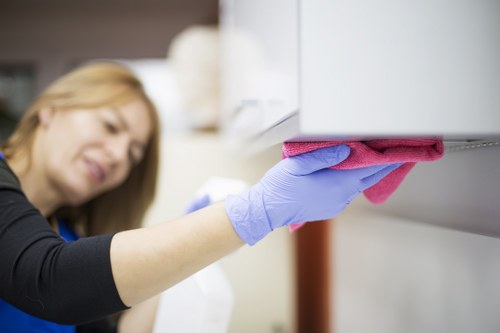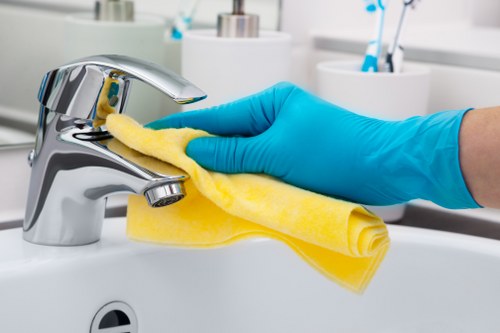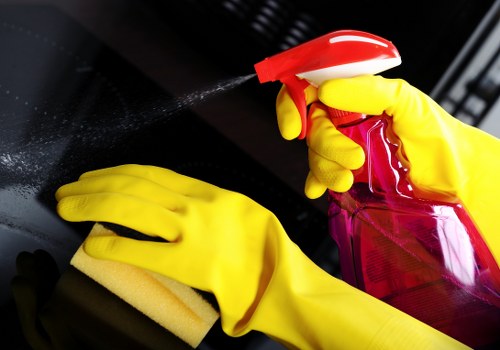Facade Cleaning in

Introduction to Facade Cleaning
Facade cleaning is an essential maintenance task for any building, whether commercial, residential, or industrial. Regular cleaning not only enhances the aesthetic appeal of a structure but also extends its lifespan by preventing the buildup of harmful contaminants. In this article, we will delve into the various aspects of facade cleaning, exploring the methods, benefits, and best practices to keep your building looking pristine.
Maintaining a clean facade is crucial for creating a positive first impression. A well-maintained exterior reflects the care and attention given to the property, which can be particularly important for businesses aiming to attract customers. Moreover, facade cleaning helps in identifying and addressing potential issues before they escalate, ensuring the structural integrity of the building.
Whether you're a property owner, manager, or someone interested in building maintenance, understanding the fundamentals of facade cleaning can help you make informed decisions and maintain a beautiful, long-lasting facade.

The Importance of Facade Cleaning
Protecting the Building's Structure
Facade cleaning plays a pivotal role in safeguarding the structural integrity of a building. Over time, various elements such as rain, wind, pollution, and biological growth like mold and algae can accumulate on the facade. These contaminants can cause degradation of building materials, leading to costly repairs and replacements.
By regularly cleaning the facade, you prevent the buildup of these harmful substances, thereby reducing the risk of damage. This proactive approach not only preserves the building's appearance but also ensures its longevity.
Additionally, a clean facade allows for easier inspection of the building's envelope, enabling early detection of cracks, leaks, or other structural issues that may need attention.
Enhancing Curb Appeal and Property Value
Aesthetic appeal is a significant factor in property value. A clean and well-maintained facade can substantially increase the attractiveness of a building, making it more appealing to potential buyers or tenants. In commercial settings, a spotless exterior can enhance brand image and customer perception, leading to increased business opportunities.
Furthermore, regular facade cleaning can prevent unsightly stains and discolorations, maintaining the building's visual appeal over time. Investing in facade maintenance is, therefore, a wise decision for both preserving and enhancing property value.
In summary, facade cleaning is not just about appearance; it's a critical aspect of building maintenance that offers both protective and economic benefits.

Common Facade Contaminants
Pollution and Environmental Factors
Urban environments expose building facades to a variety of pollutants, including dust, soot, and chemical residues from vehicle emissions and industrial activities. These pollutants can settle on surfaces, leading to discoloration and surface degradation.
Natural elements like rain, wind, and humidity can exacerbate the accumulation of these contaminants, making regular cleaning essential to prevent long-term damage.
Additionally, exposure to UV radiation from the sun can cause fading and weakening of facade materials, further highlighting the need for consistent maintenance.
Biological Growth: Mold, Algae, and Lichen
Moisture accumulation on facades creates an ideal environment for biological growth such as mold, algae, and lichen. These organisms not only mar the appearance of a building but also contribute to the deterioration of materials.
Biological growth can penetrate porous surfaces, leading to structural weakening and increased susceptibility to weather-related damage. Effective facade cleaning removes these growths, protecting the building from potential harm.
Moreover, addressing biological contaminants promptly helps maintain a healthier environment around the building, reducing allergens and other health hazards associated with mold and mildew.

Facade Cleaning Methods
High-Pressure Washing
High-pressure washing is a widely used method for cleaning building facades. This technique employs powerful water jets to dislodge and remove stubborn dirt, grime, and contaminants from surfaces.
While effective, high-pressure washing must be performed carefully to avoid causing damage to delicate materials. It's essential to adjust the pressure settings based on the type of facade to ensure thorough cleaning without compromising the integrity of the surface.
High-pressure washing is particularly suitable for concrete, brick, and stone facades, where robust cleaning is required to remove ingrained pollutants.
Chemical Cleaning
Chemical cleaning involves the application of specialized cleaning agents to break down and remove stubborn contaminants from facade surfaces. This method is effective for tackling organic stains, grease, and biological growth.
Using the appropriate cleaning solution is crucial to prevent chemical reactions that might damage the facade material. It's essential to select eco-friendly and non-corrosive agents to minimize environmental impact and ensure the safety of surrounding areas.
Chemical cleaning is often combined with other methods, such as gentle scrubbing or rinsing, to achieve optimal results.

Choosing the Right Facade Cleaning Service
Assessing Expertise and Experience
When selecting a facade cleaning service, it's vital to consider the company's expertise and experience in the field. Experienced professionals are better equipped to handle various facade materials and contaminants, ensuring effective and safe cleaning.
Look for companies that have a proven track record, positive customer reviews, and industry certifications. These indicators reflect the quality and reliability of their services.
Additionally, experienced service providers are more likely to use advanced cleaning technologies and adhere to best practices, resulting in superior outcomes.
Evaluating Equipment and Techniques
The equipment and techniques employed by a cleaning service significantly impact the effectiveness and safety of facade cleaning. Ensure that the company uses state-of-the-art equipment tailored to the specific needs of your building.
Modern technologies, such as low-pressure steam cleaning or eco-friendly chemical solutions, can provide efficient and environmentally responsible cleaning.
Furthermore, inquire about the company's safety protocols and adherence to industry standards to guarantee a secure and professional cleaning process.

Environmental Considerations
Eco-Friendly Cleaning Solutions
In today's environmentally conscious world, choosing eco-friendly facade cleaning solutions is more important than ever. These solutions minimize the environmental impact by reducing chemical runoff and energy consumption.
Biodegradable cleaning agents and low-water usage techniques are examples of environmentally responsible practices that can be adopted during facade cleaning.
Opting for green cleaning methods not only benefits the planet but also ensures the safety of the building's occupants and surrounding areas.
Waste Management and Disposal
Proper waste management is crucial during and after the facade cleaning process. Ensuring that waste water and removed contaminants are disposed of responsibly prevents environmental contamination.
Reputable cleaning services adhere to local regulations and guidelines regarding waste disposal, ensuring compliance and environmental protection.
Additionally, recycling and reusing cleaning materials where possible can further reduce the ecological footprint of facade cleaning activities.

Cost Factors in Facade Cleaning
Size and Height of the Building
The cost of facade cleaning is significantly influenced by the size and height of the building. Larger and taller buildings require more resources, specialized equipment, and additional safety measures, all of which contribute to higher costs.
Complex architectural designs may also necessitate customized cleaning approaches, further impacting the overall expense.
It's essential to obtain accurate measurements and assessments to receive a precise estimate from cleaning service providers.
Type of Contaminants and Cleaning Methods
The nature and extent of contaminants on the facade play a crucial role in determining the cost of cleaning. Heavily soiled surfaces or those with stubborn biological growth may require more intensive cleaning methods, increasing the overall cost.
Choosing specialized cleaning techniques, such as chemical cleaning or high-pressure washing, can also influence the pricing structure.
Discussing your specific needs and contaminants with the cleaning service can help in obtaining a tailored and cost-effective solution.

Benefits of Regular Facade Cleaning
Prolonging Material Lifespan
Regular facade cleaning ensures that building materials remain in good condition, preventing premature deterioration. By removing harmful contaminants, you minimize the risk of material degradation caused by environmental factors.
This proactive maintenance approach extends the lifespan of the facade, reducing the need for frequent repairs or replacements.
Investing in regular cleaning is a cost-effective strategy for preserving the integrity and appearance of your building.
Improving Energy Efficiency
A clean facade can contribute to improved energy efficiency by ensuring that insulating materials and windows function optimally. Dirt and grime can compromise the thermal performance of facades, leading to increased energy consumption for heating and cooling.
By maintaining a clean exterior, you enhance the building's ability to regulate temperature, resulting in lower energy bills and a reduced environmental footprint.
Energy-efficient buildings are not only cost-effective but also align with sustainable practices, benefiting both the property owner and the broader community.

Best Practices for Facade Cleaning
Scheduling and Frequency
Determining the appropriate schedule and frequency for facade cleaning is essential for maintaining optimal results. Factors such as local climate, environmental conditions, and the building's usage influence the cleaning intervals.
In areas with high pollution levels or frequent rainfall, more frequent cleaning may be necessary to prevent rapid accumulation of contaminants.
Establishing a regular maintenance schedule ensures that the facade remains in excellent condition, avoiding the need for intensive cleaning sessions.
Safety Measures and Compliance
Facade cleaning, especially for high-rise buildings, involves inherent risks. Adhering to stringent safety measures is crucial to protect both the cleaning crew and the occupants of the building.
Employing trained professionals who follow safety protocols, such as using harnesses and safety nets, minimizes the risk of accidents and ensures compliance with regulatory standards.
Prioritizing safety not only safeguards lives but also contributes to the smooth and efficient execution of the cleaning process.

Choosing the Right Facade Cleaning Techniques
Assessing Facade Materials
The selection of appropriate facade cleaning techniques depends largely on the materials used in the building's exterior. Different materials respond differently to various cleaning methods, making it essential to tailor the approach accordingly.
For instance, delicate materials like stucco or painted surfaces may require gentle cleaning methods to prevent damage, while more robust materials like concrete or brick can withstand high-pressure washing.
Understanding the specific requirements of your facade materials ensures effective and safe cleaning, preserving the building's aesthetic and structural integrity.
Integrating Advanced Technologies
Advancements in cleaning technologies offer more efficient and environmentally friendly solutions for facade maintenance. Techniques such as laser cleaning, ozone cleaning, and ultrasonic cleaning provide precise and effective results with minimal environmental impact.
Integrating these advanced methods can enhance the quality of facade cleaning, offering superior cleanliness and reducing the reliance on harsh chemicals.
Staying updated with the latest technologies allows building owners to adopt best practices and achieve optimal cleaning outcomes.

Maintenance Tips Post-Cleaning
Regular Inspections
After a thorough facade cleaning, conducting regular inspections helps in identifying any immediate post-cleaning issues such as residual stains or minor damages that need attention.
These inspections enable timely interventions, ensuring that the facade remains in top condition and that any potential problems are addressed promptly.
Incorporating inspections into your maintenance routine fosters proactive management of the building's exterior.
Protective Coatings and Treatments
Applying protective coatings after facade cleaning can enhance the durability and resistance of building materials against future contaminants and environmental factors.
Sealants, water-repellent treatments, and anti-graffiti coatings are examples of protective measures that can be employed to safeguard the facade.
These treatments not only prolong the time between cleaning sessions but also reduce the effort required to maintain a clean and pristine exterior.

Environmental Impact of Facade Cleaning
Sustainable Cleaning Practices
Embracing sustainable cleaning practices is essential for minimizing the environmental impact of facade maintenance. Utilizing eco-friendly cleaning agents, reducing water consumption, and minimizing waste generation are key components of sustainable facade cleaning.
Choosing green cleaning solutions that are biodegradable and non-toxic ensures that the surrounding environment and water sources remain unharmed.
Implementing water-efficient techniques, such as recycling rinse water, further contributes to resource conservation and environmental stewardship.
Regulatory Compliance
Adhering to environmental regulations and guidelines is imperative for responsible facade cleaning. Compliance ensures that cleaning activities do not violate environmental laws and that any waste produced is managed appropriately.
Professional cleaning services are well-versed in local and national regulations, ensuring that all cleaning operations are conducted within legal frameworks.
Staying compliant not only avoids potential legal repercussions but also reinforces a commitment to environmental responsibility.

Technological Advancements in Facade Cleaning
Automated Cleaning Systems
Technological innovations have introduced automated cleaning systems that enhance the efficiency and effectiveness of facade maintenance. Drones equipped with cleaning attachments can access hard-to-reach areas, providing comprehensive cleaning without the need for scaffolding or cranes.
These automated systems reduce labor costs and minimize the time required for facade cleaning, making the process more economical and less disruptive.
Moreover, automation ensures consistency in cleaning quality, achieving uniform results across the entire facade.
Smart Monitoring and Maintenance
Smart monitoring technologies, such as sensors and IoT devices, enable real-time tracking of facade conditions. These systems can detect the accumulation of contaminants, moisture levels, and structural changes, providing valuable data for proactive maintenance.
Integrating smart monitoring with facade cleaning schedules ensures timely interventions, optimizing maintenance efforts and preventing extensive damage.
Embracing smart technologies enhances the overall management of building maintenance, leading to more sustainable and efficient operations.

Case Studies: Successful Facade Cleaning Projects
Commercial Building Transformation
A prominent commercial building underwent a comprehensive facade cleaning project that revitalized its appearance and extended its lifespan. Utilizing high-pressure washing combined with chemical cleaning, the cleaning team effectively removed years of pollution and biological growth.
The result was a strikingly clean and vibrant facade that significantly enhanced the building's curb appeal, attracting more customers and tenants.
This case exemplifies the transformative impact of professional facade cleaning services on commercial properties.
Residential Facade Maintenance
In a residential setting, regular facade cleaning helped preserve the integrity of brickwork and painted surfaces. The application of protective coatings post-cleaning ensured long-term resistance against weathering and contaminants.
Homeowners reported improved energy efficiency and a renewed aesthetic appeal, demonstrating the tangible benefits of consistent facade maintenance.
Such success stories highlight the value of investing in facade cleaning for both aesthetic and structural advantages.

Challenges in Facade Cleaning
Accessing High-Rise Buildings
Cleaning the facades of high-rise buildings presents unique challenges due to the difficulty in accessing elevated areas safely. Specialized equipment such as suspended scaffolding, aerial platforms, or rope access techniques are required to reach these heights.
Ensuring the safety of workers while maintaining efficiency is paramount, necessitating meticulous planning and adherence to safety protocols.
Advanced training and certification are essential for personnel involved in high-rise facade cleaning to mitigate risks and ensure successful operations.
Dealing with Delicate Materials
Facades constructed from delicate materials like stucco, limestone, or historical bricks require gentle cleaning methods to prevent damage. Aggressive cleaning techniques can erode these materials, leading to costly repairs and loss of historical value.
Employing appropriate cleaning solutions and methods tailored to the specific material is crucial for preserving the integrity and appearance of the facade.
Collaborating with experts who understand the nuances of various facade materials ensures effective and safe cleaning outcomes.

Future Trends in Facade Cleaning
Green Cleaning Technologies
The future of facade cleaning lies in the adoption of green technologies that prioritize environmental sustainability. Innovations such as waterless cleaning solutions, biodegradable detergents, and energy-efficient equipment are becoming increasingly prevalent.
These advancements reduce the ecological footprint of cleaning operations, aligning with global efforts to promote sustainability.
Embracing green cleaning practices not only benefits the environment but also enhances the reputation of businesses committed to responsible maintenance.
Integration with Building Management Systems
Integrating facade cleaning with smart building management systems allows for seamless coordination of maintenance activities. Real-time data from sensors can trigger automated cleaning schedules, ensuring that facades remain clean without manual intervention.
This integration enhances efficiency, reduces labor costs, and ensures that cleaning efforts are aligned with the building's operational needs.
The convergence of facade cleaning with advanced building technologies represents a significant step towards intelligent and automated building maintenance.

Conclusion
Facade cleaning is a critical aspect of building maintenance that offers numerous benefits, including enhanced aesthetic appeal, structural protection, and increased property value. By understanding the various cleaning methods, choosing the right service providers, and adopting best practices, building owners can ensure that their facades remain in excellent condition for years to come.
Investing in regular and professional facade cleaning not only preserves the beauty and integrity of a building but also contributes to a sustainable and healthy environment. As technological advancements continue to evolve, the future of facade cleaning promises more efficient, eco-friendly, and intelligent solutions, further elevating the standards of building maintenance.
Don’t wait until grime and contaminants take a toll on your building’s facade. Contact us today to schedule your professional facade cleaning service and maintain the beauty and longevity of your property.






